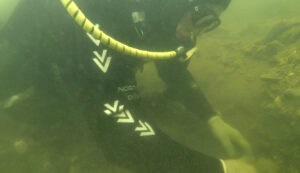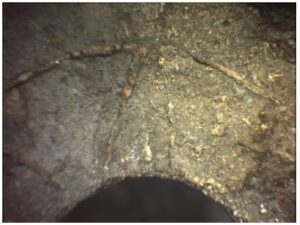August ’20
Lead Inkwell
August’s Object of the Month is a small, lead inkwell from the River Wear.
The Site

Between 2008 and 2019, archaeological investigations of a submerged river bed, positioned just downstream of the twelfth century Elvet Bridge in Durham City, County Durham, have revealed an important multi-period underwater archaeological site. This site has eventually yielded a significant collection of typically small metal finds, the total number of which now exceeds 13,000 objects.

The find site, positioned just downstream of the twelfth century Elvet Bridge in Durham City, lies mid-way between two areas of late-medieval urban development: the Borough of New Elvet and the Bishop’s Borough. The late-medieval city of Durham comprised of five boroughs, the tenements located in the Bishop’s Borough, positioned immediately to the west of the find site, were known as Saddlergate (now Saddler Street), while the tenements which abut the river to the east (in the Borough of New Elvet) were simply referred to as the western edge of New Elvet.
The Object
A cast lead cube-shaped inkwell likely manufactured in the 16th century. It was cast in two pieces, the well, and the lid, the latter having had its corners hammered down and soldered on to the well. Incised decoration is present around the inkwell opening, in the shape of projecting lines, often arranged into triangles, which emanate from the opening to another surrounding circle.

The inkwell was made from lead, which could have been chosen for several reasons. Firstly, it was readily available in the north-east and thus cheap to use. Lead has been mined extensively in Weardale and in other parts of England from Roman times on, with the Prince Bishops encouraging the development of the industry from the 12th century. Secondly, lead was known for its resistance to corrosion, having been used in plumbing from as early as Fifth Dynasty Egypt. Furthermore, its low melting point (327°C) made it straightforward to cast. Each of these features makes lead a practical material for the Wear inkwell.

The object bears only rudimentary decoration and only on the top surface. There, a shallow circle has been formed around the inkwell opening. Between the two circles are a series of additional lines, most pointing outward to form triangles, but some on their own. The object’s connection to Durham may be significant in explaining this decoration. The Cathedral was a major influence on Durham life, but its status as a centre of learning and its monastic heritage made it perhaps the prime centre of literacy in the north-east of England. It was a major consumer in the stationary and bookselling trade, fuelling the industry. It would be unsurprising, therefore, to find decoration of Christian significance upon objects associated with this trade. However, given the personal nature of the decoration, the image is unlikely to correspond precisely with more recognised images and its meaning may remain a mystery.
The object was first identified as being from the 16th century by Geoff Egan, National Finds Advisor for the Portable Antiquities scheme, when he viewed parts of the River Wear collection in 2010. The object was recovered in a layer below objects from the 18th century onward, ruling out these dates. Prior to 1500, with low levels of literacy, there was little demand for writing materials outside of monasteries. Scribes were itinerant: they valued portability in their writing equipment. Their inkwells, commonly termed as ‘inkhorns’ due to that material being commonly used, may have had holes for drawstrings and a longer, tapered shape to make it easier to carry and seal. Portability is clearly lacking in the Wear inkwell. In addition, a scribe’s inkhorn would have been a more complex item for a professional, perhaps incorporating a case for quill pens. Examples have been found made of horn, and lined with pottery, metal and glass. By contrast, the Wear inkwell is very basic. It must come from a time when such basic items were in demand. Only in the post-medieval period, particularly in the 16th century, was this demand in place, thanks to a significant expansion of literacy and a culture of writing.

The expansion of business and the professions helped to spread a culture of writing, as did the increasing centralisation of royal power under the Tudor monarchs – a growing bureaucracy demanded literate men. These factors fed into increased demand for cheap writing materials for use in the home or business. Through comparison with other objects from the period, the Wear inkwell appears to be at the very bottom of this market. Even objects closer to the Wear inkwell in form and manufacture often have additional features. Simple inkwells had holes for quills. Comparative examples from the Portable Antiquities scheme have neater decoration, in the form of grooves or fluted bodies, which may have been applied using machinery. This tells us that cheap inkwells need not have been made by cheap methods. This interpretation is assisted by the object’s provenance. Durham, as we have seen, was a centre of literacy and written culture in the north-east. Cathedral accounts from the seventeenth century show that one bookseller made most of his turnover from stationary, and the Cathedral] bought great quantities of ink, quills, paper, parchment and the like. This high demand helps to explain how such a basic, unadorned object might get into the marketplace when literacy was by no means universal.
Stay tuned for next month’s object!
